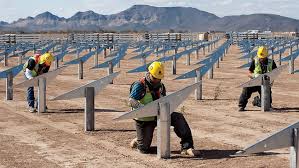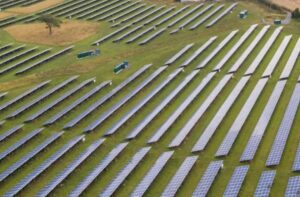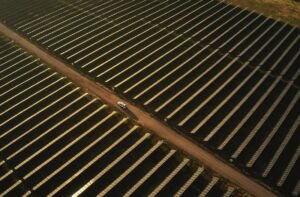The Clean Energy Finance Corporation is to tip another $250 million of financing into large-scale solar projects, as part of a coordinated drive among government agencies to build up to 10 major projects and drive down the cost of large scale solar.
 The CEFC commitment adds to the $100 million in grants being made available by the Australian Renewable Energy Agency, and comes as governments in the ACT and Queensland seek large-scale solar projects to meet their renewable energy targets, and utilities such as Ergon Energy also seek large-scale solar projects.
The CEFC commitment adds to the $100 million in grants being made available by the Australian Renewable Energy Agency, and comes as governments in the ACT and Queensland seek large-scale solar projects to meet their renewable energy targets, and utilities such as Ergon Energy also seek large-scale solar projects.
The financing from the CEFC was announced at the Disruption and the Energy Industry Conference hosted by RenewEconomy in Sydney on Wednesday. The program will be targeted at projects of 10MW or more, with loan requirements of $15 million or more.
“The CEFC finance will be available over a longer term, at a fixed rate,” said chief investment officer Ted Dow. “We see this as critical to providing added certainty and confidence to developers and producers in the large scale solar supply chain, which is still developing in Australia.”
Australia has trailed other OECD countries in the deployment of large-scale solar, despite its superior solar resources. But it seems increasingly clear that large-scale solar is soon to displace wind energy as the major contributor to Australia’s renewable energy commitments.
This has been the express wish of the Abbott government, which has expressed its dislike of the technology, moved to stop the CEFC from supporting wind projects, and supported a Senate finding that has proposed tough new restrictions on wind farms.
But analysts say large scale solar projects will be boosted by economics. They say that large-scale solar could match the cost of wind energy within a few years, and the funding programs launched by CEFC and ARENA are designed to accelerate that process.
ARENA says solar costs can match wind costs by 2020, with lower-cost finance a key. Just the difference in cost of capital can add one quarter to large-scale solar costs. Private developers such as Canadian Solar say that costs of large-scale solar could halve within five years, based around lower costs for finance and the supply chain.
ARENA earlier this week announced details of its tender for 200MW of large scale solar projects – with a minimum size of 5MW, for grants up to $30 million.
This tender and the CEFC program is expected to dovetail with the Ergon Energy tender for 150MW of large-scale renewables in Queensland, most of which is expected to by large-scale solar. Ergon will soon commence another tender of around 50MW of solar to meet its remote area energy needs.
The ACT government is currently looking at proposals for 50MW of “next generation” solar which will combine solar technologies with storage, and was swamped by proposals totalling nearly 1,000MW.
The Queensland government is also expected to directly commission around 60MW of large-scale solar – increased from its previous target of 40MW – to be held under the auspices of the ARENA auction. The Victorian government is considering proposals for a power purchase agreement to power its tram network, in the largest such deal in the world. A 30MW solar plant has been mooted.
There are now dozens of different solar projects around Australia, ranging from proposals for plants of around 10MW for councils such as Sunshine Coast and Fremantle, to mega projects such as the 2GW plant being proposed for Queensland by Solar Choice.
Origin Energy and Bloomberg New Energy Finance both predict that large-scale solar will account for the majority of the 5,000 to 6,000MW of large-scale renewable energy plants needed to meet the revised 2020 target of 33,000GWh.
ARENA CEO Ivor Frischknecht said the focus on solar reflects the numerous projects on the drawing board.
“Australia has huge natural advantages in this area: more sun than almost anywhere else and a solar R&D sector that is the envy of the world,” Frischknecht said.
“The funding round is about unlocking that capability to deploy large-scale solar farms across the nation. This will drive further innovation in the sector and create efficiencies in Australia’s solar PV supply chains.”
CEFC’s Dow says the installation of large-scale solar has lagged behind residential solar, which is estimated to reach about 5,000MW of installed capacity this year
“While the costs of large-scale solar PV are decreasing, this financing boost will help Australian projects move down the cost curve, in line with international trends,” Dow said.
He said the CEFC finance would be available for projects which had power purchase agreements, as well as those proposing to take some merchant risk.
“We will also seek to catalyse other sources of finance to support large scale solar developments, through co-investment in debt and equity.
“In this way, we can help fill the funding gap in the large-scale solar sector, and encourage greater participation by banks and other institutions as the sector expands and develops a track record of proven credit and operational performance.”
The CEFC and ARENA are already heavily involved in supporting the largest projects to date, including funding most of the 57MW Moree solar plant currently under construction, and ARENA funding supported the recently completed 102MW Nyngan solar plant and the under construction 53MW Broken Hill solar plant.
The CEFC has also provided $15 million towards Australia’s largest solar and battery storage project to date, at Sandfire Resources’ DeGrussa copper mine in Western Australia, $17 million towards remote solar projects in the Northern Territory, support for the Royalla solar farm in the ACT, which received finance from the NAB Climate Bond, in which the CEFC was a cornerstone investor, and helped South Australian-based Sundrop Farms secure capital for its approximately $150 million innovative application of solar thermal technology.








